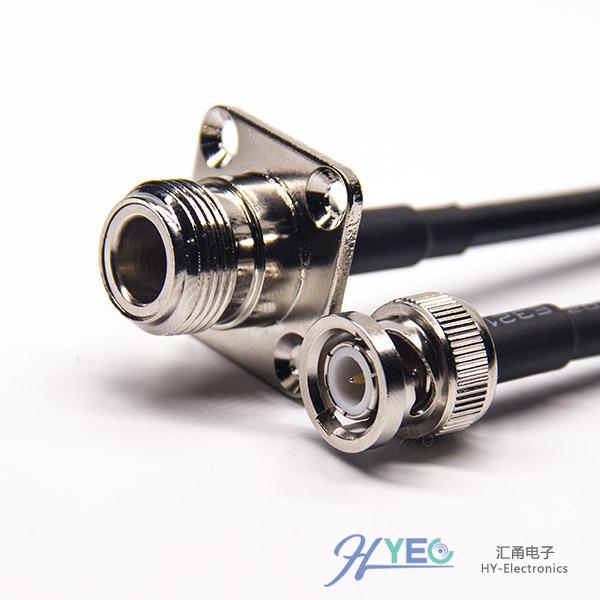Classification and implementation standards for RF coaxial cables
Classification of RF coaxial cables
RF coaxial cables are divided into semi-rigid, semi-flexible, flexible and bellows cables. Different types of cables should be selected for different applications. Semi-rigid and semi-flexible cables are generally used for interconnection inside equipment; in the field of test and measurement, flexible cables are often used; bellows cables are often used in antenna feeder systems.
Semi-rigid cable
As the name implies, this cable is not easily bent and formed. The outer conductor is made of aluminum or copper (see Figure 1.11). The RF leakage is very small (less than -120dB), and the signal crosstalk caused in the system can be neglected. Excluding. The passive intermodulation characteristics of this cable are also ideal. If you want to bend to a certain shape, you need a special molding machine or a manual mold to complete. Such troublesome processing technology is very stable performance, semi-rigid cable usually uses solid PTFE material as filling medium, this material has very stable temperature characteristics, especially under high temperature conditions, very good Phase stability.

Semi-rigid cables cost more than semi-flexible cables and are used in a variety of RF and microwave systems.
2. Semi-flexible cable
In some cases, semi-flexible cables are a replacement for semi-rigid cables that are similar in performance to semi-rigid cables and can be formed by hand. However, its stability is slightly worse than that of a semi-rigid cable. Since it can be easily formed, it is also easily deformed, especially in the case of long-term use.
3. Flexible (woven) cable
Most of the "test grade" cable assemblies use flexible cables. Flexible cables are expensive compared to semi-rigid and semi-flexible cables because flexible cables are designed with more factors in mind. Flexible cables need to be able to bend multiple times and maintain performance, which is the most basic requirement for test cables. Softness and good electrical indicators are a contradiction and are the main reason for the high cost.
The choice of flexible RF cable assemblies requires consideration of various factors at the same time, and some of these factors are contradictory. For example, the coaxial cable with a single inner conductor has a lower insertion loss than the multiple strands. Stability, but phase stability is not as good as the latter. Therefore, in addition to the frequency range, standing wave ratio, insertion loss and other factors, the selection of a cable component should also consider the mechanical characteristics, operating environment and application requirements of the cable. In addition, cost is also a constant factor.
4. Bellows cable
The outer conductor of the bellows cable is a corrugated copper tube. In recent years, aluminum tubes have also appeared. This type of cable has a low loss design and is often used in antenna feeder systems.
The corrugated outer conductor design has the advantage of being easy to bend and transport, while also having good tensile properties for vertical suspension applications of the cable.
Coaxial cable implementation standard
The use of coaxial cable is not isolated. In addition to meeting the impedance criteria, there is an important constraint that is compatible with the connector. After decades of development, the mainstream standard for general-purpose RF cables has tended to be the US military standard MIL-C-7. Most mainstream connector manufacturers also design corresponding connectors according to MIL-C-17 compliant RG series cables. In China, RF coaxial cable is usually designed and manufactured using the SJ1563 and SJ1132 standards of the former Ministry of Electronics Industry (Four Parts). Some parameters in this standard are close to the MIL-C-17 standard. Currently, the domestic mainstream cable factory Still in accordance with these standards. Table 1.5 compares the parameters of two common cables.
In order to achieve the best VSWR performance of the cable assembly, it is best to use connectors that are manufactured to the corresponding standards. With the integration trend of the global economy, market behavior will determine the unification of standards.
1. Low loss RF coaxial cable
In the case of high-power signal transmission, reducing the cable loss is much more cost-effective than increasing the transmission power. Therefore, cable designers are constantly improving the parameters of the cable in order to achieve lower losses. To reduce the loss of the cable, the most effective measure is to lower the dielectric constant of the true charge medium. A limiting case is the feed tube commonly found in broadcast television transmission systems. This transmission line uses an air medium to fix the inner conductor through some PTFE support rods with a dielectric constant close to one.
In the field of mobile communication applications, physically foamed polyethylene (PE) material is often used as a filling medium, and its dielectric
The constant is 1.29-1.64. After the dielectric constant is lowered, how to ensure that the characteristic impedance of the cable is still 50 ohms? It can be seen from the equation (1.1) that when εr is low, Ig(D/d) must be simultaneously reduced. A common method is to increase d, which is the outer diameter of the inner conductor. However, the problem that comes with it is that the commonly used connectors are not suitable for such low-loss cables, so many new RF cable and connector series have appeared.
2. Microwave coaxial cable
There is no uniform standard for microwave cables above 18 GHz. This field can be described by "eight immortals crossing the sea, each showing its power." Almost every microwave cable manufacturer produces microwave cables in accordance with its own corporate standards. In order to ensure signal transmission efficiency at higher frequencies, most microwave cables use low-density PTFE media with a dielectric constant of 1.38 to 1.73. Therefore, under the premise that the outer conductor is equivalent, the inner conductor of the microwave cable is larger than the ordinary RG cable. Few microwave cable manufacturers disclose the dimensions of the inner and outer conductors of their cables in their catalogue.
